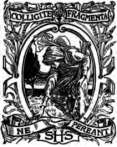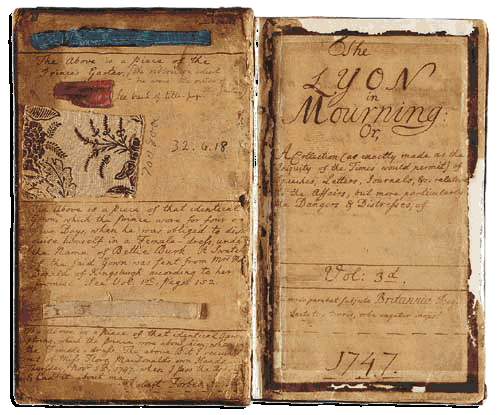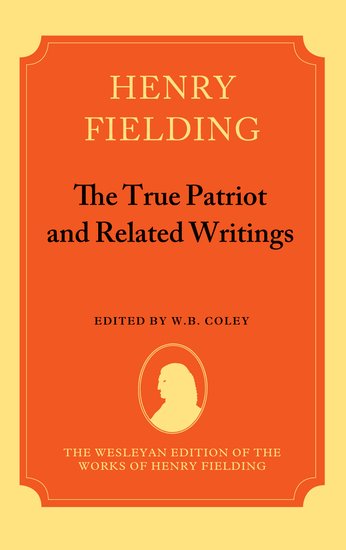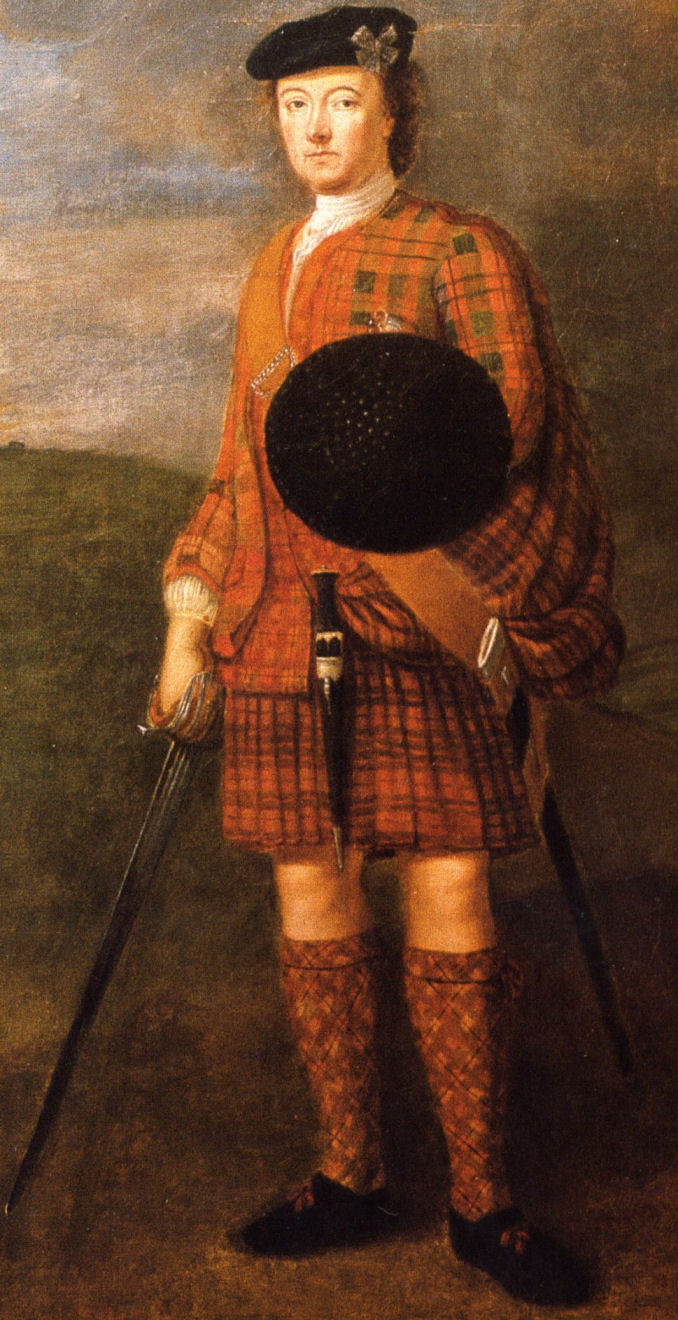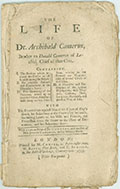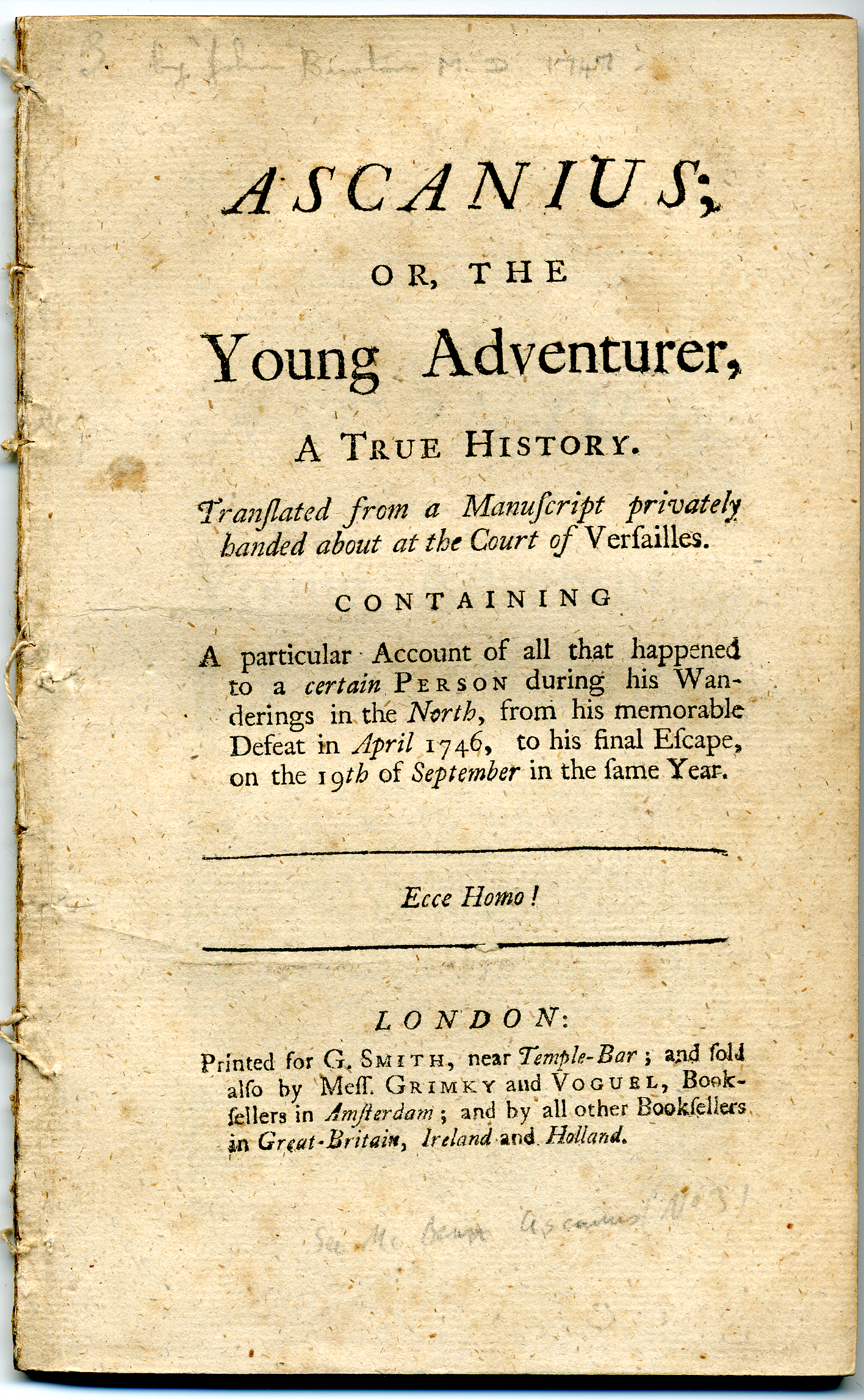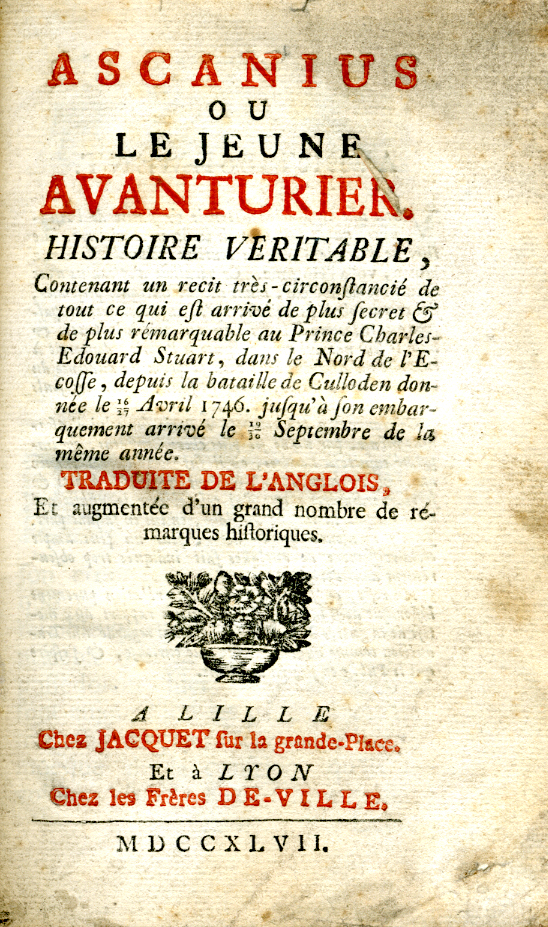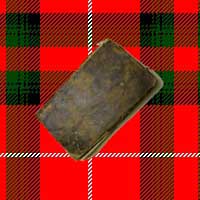
Ascanius; or, the Young Adventurer
Bestselling book of the 18th and 19th centuries
home
|
|
|
The intention is to create a fully transcribed library of all the books or memoirs written by the participants in the 1745-6 Jacobite Rebellion. These books are delivered in a unique format with links to any and all information I have found (including place name resolution using my map of the Jacobite Rebellion). These links are automatically populated by my Historical Timeline software. All of these books are
out of copyright and transcribed (some are only scanned)
by
Dave Waddell and are licensed under a
January 9th, 2010 (Latest content on December 21, 2018) P.S. I personally want
to thank the
Scottish History Society (SHS) for bringing so many
of these
publications to light since 1887. I also want to
thank
Currently, (March 23, 2017) there are 211 transcribed books and over 600 transcribed documents (in seven languages) related to the 1745-6 rebellion. There are also four books awaiting republication.
There are also the four volumes by William Drummond
Norie:- Many versions of
Ascanius; or, the Young Adventurer are online
and can be found in the
Ascanius Blog. I personally own
twenty-one copies.
Act for a company trading to Africa and the Indies,
26 June 1695
Treaty of Fontainebleau 24 October 1745 signed
by Marquis d‘Argenson and O‘Brien. Declaration by ‘Prince Charles’, issued in Paris, 1745. Orders for Volunteers issued from Holyroodhouse on 22nd October 1745. Alleged Letter by Frederick of Prussia translated from the original French by Lord George Murray. From an article in Index Supplement to the Notes and Queries, with No. 185, July 15,1871 on pages 117-8. Copy of letter from [A. Campbell] 3rd Duke of Argyll to Sir John Cope; n.d. [c. Aug 1745], enclosed in General Cope's letter of 13 Aug. 1745 to Henry Pelham regarding the arrival of Charles Edward Stuart in Scotland. Edward Linn of the Royal North British Fuziliers. A letter from a private soldier of Barrel's regiment, at Edinburgh, dated Jan 19th 1746 From the Gentlemen's Magazine Vol. XVI 1746. Donald Mackay of Acmonie, Glen Urquhart – Jacobite volunteer soldier. Donald Campbell of Airds, Highland officer with the Government army. A Relic of the Forty Five from the The Diary of James Miller of the Manchester Regiment. March of the Highland Army from the Day Book of James Stuart. The Stuart MSS. contain the following Report on the operations of the Prince in England, from which the writer, Laurence Woulfe, had just returned. From Derby in the '45 Appendix K by L. Eardley-Simpson M.A, LL.B. (Cantab.). Jacobite Rumours by Henrietta Tayler from a letter of Angus MacDonell addressed to his cousin, Coll MacDonell of Barisdale. Robert Colquhoun, fourteenth of Camstradden. Battle of Clifton Moor as described by Thomas Savage to his friend Richard Partridge and also by Tom Tinkler To His Cousin. Letter from George Jonestone, Musselburgh [Midlothian, Scotland], to Henry Pelham; 21 Jan. 1745/6, endorsed 'Account of Action in Scotland, 1745/6' following the Battle of Falkirk. Letter from General Thomas Wentworth, Newcastle-upon-Tyne, to Henry Pelham; 10 Nov. 1745. Letter from Morpheus Landlowper, Edinburgh, to Henry Pelham; 10 December 1746. Letter from Lord George Murray to his wife following the Battle of Falkirk. This one letter, not only explains his reasons for stopping the charging Highlanders from destroying the routed militia, but also explains volumes about the character of Lord George. Letter from J. O'Hara, 2nd Baron Tyrawly, Newcastle-upon-Tyne, to Henry Pelham; 11th November 1745. Transcription of a Letter from Sir Everard Fawkener (secretary to the Duke of Cumberland) to Henry Pelham (Prime Minister of Great Britain) dated at Inverness 18th April 1746. Also announcing the arrival of Lord Cromarty and his son Lord McLeod on board the Hound sloop (Captain Dove). Transcription of a Letter from Major-General Humphrey Bland, Fort Augustus [Inverness-shire, Scotland], to Henry Pelham (Prime Minister of Great Britain); 9 Jun. 1746. Disposal of the La Seine ship that carried Lord John Drummond. Letters to the Laird of Stonywood. A letter to the Right Honourable the E---l of T---q---r (Earl of Traquair). Extracts from the diary of the reverend John Bisset. Various letters from The Highlanders at Macclesfield in 1745 by Walter Biggar Blaikie (WBB) and published in the Scottish Historical Review VOL. VI., No. 23 for April 1909 page 225. Following on from Part 1 in Scottish Historical Review VOL. V., No. 19 for April 1908 page 285. A LETTER to the Author of the National Journal. Correspondence of Archbishop Herring and Lord Hardwicke during the Rebellion of 1745. By R. Garnett, Thomas Herring (Archbishop of York [later Canterbury]) and Lord Hardwicke from The English Historical Review - Volume 19, No. 75 of July 1904 pages 528-550. Part II followed in No. 76 of October 1904 on pages 719-742. TWO ACCOUNTS OF THE ESCAPE OF PRINCE CHARLES EDWARD - Edited by Henrietta Tayler for the Luttrell Society by Basil Blackwell. The capture of the Prince Charles Stuart snow (formerly the Hazard sloop captured at Montrose). Letter from Lord Albemarle to the Duke of Newcastle with the List Of Prisoners, Delivered to Commodore Smith by Major General Campbell, Augt 3rd, 1746. A Journey through part of England and Scotland by a Volunteer in the Duke of Cumberland's Army (1747) as a series of letters to his friend in London. Three letters from Charles and Henry from the Third Report of the Royal Commission on Historical Manuscripts regarding Cluny Macpherson and Clementina Walkinshaw. The Culloden Papers by Duncan Forbes (they are, currently, only fully corrected from letter CCXLV sent to Mr. Pelham to inform him of the rumour of Charles' landing and dated 2nd August 1745). The Journal of Elizabeth "Beppy" Byrom in 1745, eldest daughter of John Byrom the poet from Manchester, provides an interesting perspective of a 24 year-old girl. Letters to and from
Charles regarding his arrival in France from Scotland
from the Stuart Papers at Windsor. Also, from the Stuart
Papers and extracted from the Appendix of Lord Mahon's
(Philip
Henry Stanhope)
History of England from the peace of Utrecht to
the peace of Paris, Volume 2. More from the
same location but derived from the
Grantham and Hardwick, Coxe's collection, and the State
Papers. The extremely difficult to find correspondence from volume two of William Fraser's Chiefs of Grant dealing with the 1745-6 rebellion. From the first arrival of Charles Edward Stuart to shortly after the death of Sir Ludovick Grant. The original can be read here. A letter from Henry Goring Esq. (1750) supposedly dealing with part of Charles Edward Stuart's travels after leaving Avignon on 25 February 1749. While not unreasonable it was, in fact, a work of fiction by Eliza Fowler Haywood for which she was arrested as a Jacobite sympathizer. Report on the manuscripts of the Marquess of Lothian, preserved at Blickling Hall from the Historical Manuscripts Commission contains details of the effects of the rebellion on the London Stock Exchange. It also mentions the presence of several officers in Leicester seeking lodging for the army on the night of December 5th, 1745. Also mention is made of a capture of an English ship by the Prince de Country (surely the Prince de Conti that was one of the ships that rescued Charles) out of St. Malo. The intrigues of the exiled did not end with the suppression of the rebellion as noted in the Manuscripts of the Duke of Leeds (Holdernesse Papers), from the Eleventh Report, Part Seven of the HISTORICAL MANUSCRIPTS COMMISSION. In particular those of James Drummond (MacGregor) of Bohaldie. The Roxburghe Club -
Volume 59 (1843) is
The Decline of the Last Stuarts.
This pamphlet supposedly contains The Genuine Dying Speech of Parson Coppock. An extraction of two letters written by Major James Wolfe (later General)(regarding the Battle of Culloden) April 17, 1746 from Wolfe in Scotland in the '45 and from 1749 to 1753, by J. T. Findlay. Notes and letters from The Tissington MSS and the Rebellion of '45 as printed in volume 30 of The Antiquary of 1894. Letters from A History of the Ancient Parish of Leek by John Sleigh (1862). A section from Memoirs of the administration of the Right Honourable Henry Pelham dealing with events up to, including, and shortly after the 1745-6 rebellion. The Father Innes Papers from the Scots College in Paris extracted from The Spalding Club Miscellany Volume II (1842) by John Stuart. This contains a facsimile letter to Henry Innes congratulating him on becoming Procurator in 1777 and is signed Charles R. There is also a letter in Papers of the Scots College at Paris by A. Trip in The Monthly Magazine; or, British Register (1804). Account of Manuscripts in the Scotch College at Paris was published in The Scots Magazine, Volume 70 (1808). The Young Pretender's Destiny Unfolded is a letter produced in a pamphlet dated 1745 purportedly from a clergyman in the Isle of Skye to a friend in London. The Woodhouselee MS. by Charles E. S. Chambers, Patrick Crichton, Archibald Francis Steuart (1907). Letters from The Manuscripts of the Earl of Lonsdale by Hugh Cecil Lowther Lonsdale (Earl of) from the Thirteenth Report, Appendix, Part VII of the Royal Commission on Historical Manuscripts on page 126. Charles Edward Stuart
was very pleased to meet his extended family with the
Duc de Bouillon and wrote to his father (parts extracted
from
Mémoires du duc de Luynes sur la cour de
Louis XV [1735-1758]). Two letters from John Erskine to Charles Wesley in September 1745 A letter from Lady Irwin to the Earl of Morton in December 1745 A letter from Robert Gardiner (Brother of Colonel Gardiner) to Lord Stair in November 1745. Letters from Francis Kennedy regarding The Siege of Edinburgh from the Scottish Historical Review Volume VIII page 53 (1911). Copy of the Declaration of Miss MacDonald, relating to the Pretender’s Son. Given to General John Campbell of Mamore at Apple Cross, July 12 1746. Correspondence of Baron Mure from Selections from the Family Papers Preserved at Caldwell. Part II. Vol. I. page 68 (1854). Presented to the Maitland Club of Glasgow by William Mure of Caldwell. The Diary of John Campbell, banker at the Royal Bank of Scotland in Edinburgh from the Scottish History Society Miscellany Volume I (Edinburgh, 1893, pp.537-59). In 1995 the Royal Bank produced a booklet with the complete content and a useful list of names and places such as Old Bank—Bank of Scotland, at Old Bank Close on the north side of the Lawnmarket, Edinburgh. Earl of Marchmont's Diary from A selection from the papers of the earls of Marchmont, in the ..., Volume 1 By Patrick Hume Marchmont (Earl of), Alexander Hume-Campbell Marchmont (Earl of), Hugh Hume Marchmont (Earl of)(1831). This includes two accounts of the Battle of Falkirk at the end. An epistle from a British lady to her countrywomen (1745). Manuscripts in the Charter Chest at Cluny Castle Inverness-Shire : relating to the Clan Chattan and the Cluny of 1745 (1879). Letter from Patrick Fea to Sir James Stewart of Burray—30th March 1746 warning him to safeguard the arms and ammunition on board of Captain Sinclair's ship, the Providence, for use by Bonnie Prince Charlie. Relics of the Rebellion from the Spottiswoode Miscellany Volume II edited by James Maidment (1845). Incidents in the Risings of 1715 and 1745 from The Transactions of the Gaelic Society of Glasgow. October 27th, 1891. by Charles Fraser-Mackintosh. Memoirs of a royal chaplain, 1729-1763 - the correspondence of Edmund Pyle (1905).
Harangue faite par Charles Edouard d'Ecosse, à son armée,
après avoir remporté la victoire sur le général Cope,
dans le comté d'Archite, le 1/12 Septembre; traduite
de l'Anglois par M. Ohalon, ci-devant Avocat au Parlement
de Paris. Letters from Mrs. Grant of Laggan to Sir Henry Steuart of Allanton. Published by the Scottish History Society as part of Publication 26 in 1896. Coming soon are (a transcription
is available
here)
Cordara's History of the expedition, originally
written in Latin and translated into Italian by Antonia
Gussalli in 1845 as
La spedizione di Carlo Odoardo Stuart negli anni
1743- 44- 45- 46 The Trial of Archibald Stewart Esq; Lord Provost of Edinburgh and his friend, David Hume's, brilliant but anonymous pamphlet A true account of the behaviour and conduct of Archibald Stewart, Esq.; late Lord Provost of Edinburgh printed in his defence. In July 2010, I was able
to read the, almost impossible to find,
A Jacobite Miscellany by
Henrietta Tayler
produced by the Roxburghe Club in 1948. This book has
been transcribed and presented to the Club for republication
as it offers insights previously unknown, which, because
of its limited circulation, have remained hidden for
almost sixty years. I now own a copy of this beautiful
book and I have been given permission by
The Roxburghe Club to publish the PDF version in full.
Ship's Log of the DuTeillay from
Une Famille Royaliste, Irlandaise et Française,
et Le Prince Charles-Édouard Jacobite Ciphers or cyphers. Itinerary of Prince Charles Edward Stuart from his landing in Scotland July 1745 to his departure in September 1746. By Robert Forbes, Walter Biggar Blaikie (WBB). Corrected in W.B. Blaikie's, The first news that reached Edinburgh of the landing of Prince Charles, 1745, in SHR 23, 1926, p. 161-170. Also by WBB is Origins of the 'Forty-Five.
Also by Robert Forbes is Jacobite Memoirs of the Rebellion of 1745 which includes Lord George Murray's Marches of the Highland Army and A plain, authentick, and faithful narrative of the several passages of the Young Chevalier writing under the pseudonym Philalethes in 1750. The Lockhart papers - Volumes One and Two. These volumes are large and deal mostly with letters before the 1745-6 rebellion. The first volume is hardly edited and the second is only lightly edited before events of the '45. Henry Fielding's pamphlet (published in October 1745 shortly after the government defeat at the Battle of Prestonpans) is called The History of the Present Rebellion In Scotland. Also his A DIALOGUE BETWEEN The DEVIL, the POPE, AND THE PRETENDER is published. The Medical and Surgical Aspects of the 'Forty-Five. The Memorials of John Murray of Broughton: sometime secretary to Prince Charles. Narrative by John Mackenzie, LORD MACLEOD eldest son of the Earl of Cromartie. David, Lord Elcho's A Short Account of the Affairs of Scotland in the years 1744, 1745, and 1746 (with maps [larger download]). Declaration of Captain Felix O'Neil. James Maxwell of Kirconnell's narrative. The following account of the Skirmish at Clifton is extracted from the manuscript Memoirs of Evan Macpherson of Cluny, Chief of the clan Macpherson is in the Appendix of Sir Walter Scott's Waverley. Another account of the skirmish can be found in The Retreat of the Highlanders through Westmoreland in 1745. Chevalier de Johnstone's memoirs volume One (I also have Two and Three but they're less relevant to the story dealing with Johnstone's escape to the continent and his subsequent life in Canada). There is also an edition translated in 1820. This is the story of the Highlander's greatest weapon - the basket-hilted broadsword - commonly known as an Andrew Ferrara. Prince Charlie's Pilot Donald MacLeod - The Faithful Palinurus. Dalilea manuscript. Originally published in 1873 in The Edinburgh monthly magazine [afterwards] Blackwood's Edinburgh ..., Volume 114 page 408 as A true and real state of Prince Charles Stuart’s miraculous escape after the battle of Cullodden. The Plundering of Cullen House by the Rebels. The Siege of Blair Castle by Lord George Murray. An original and genuine Narrative, now first published, of the remarkable Blockade and Attack of Blair-castle by Ensign Melville of Sempill's Regiment who went on to become a Lieutenant General printed in The Scots Magazine, volume 70 (1808). The Highland Forts in the ‘Forty-Five’ by C. L. Kingsford in the English Historical Review volume 37 for 1922 which includes the Diary of Captain Caroline Scott. The very difficult to find Young Juba by M. Michell (pseudonym for Michael [Michel, Michele] Vizazi [Vizzosi]- Charles' valet) although clearly edited by a government supporter. Mémoire d'un Écossais by Donald "The Gentle Lochiel" Cameron, XIX Chief of Clan Cameron, April 1747. James Dennistoun Memoirs of Sir Robert Strange Knt., engraver and of his brother Andrew Lumisden Volume I and Two.
From the French periodical
Revue rétrospective Volume 3 Jul-Dec
1885 are the letters sent by the marquis d’Eguilles,
sometimes known as the French Ambassador -
Correspondance inédite du marquis d’Eguilles.
He was arrested after the Battle of Culloden and was
under parole first in Inverness then Carlisle and finally
returning home via Berwick, Newcastle, and
Flessingue in Holland with a prisoner exchange in
May 1747. He sorely missed his family and friends and
wrote prolifically about the rebellion and the conditions
afterwards. A compleat history of the rebellion, From its first Rise, in 1745, To its total Suppression at the glorious Battle of Culloden, in April, 1746 by James Ray of Whitehaven.
Geschichte des englischen Cron-Prätendentens.
Discursos exortatorios, que hizo a su exercito su Alteza
Real Carlos Stuardo, Principe de Gales (1745)
translated for Doctor John Lacy. An original version
can be found
here.
Empresa, victorias y desgracias de el principe Carlos
Eduardo Stuard Pretendiente de Inglaterra,
Residente en Roma
Traducido de el Frances al Castellano por D. Victor
Amadeo Maria. Caballero de la Borie, Capitan agregado
al Estado Mayor de la Plaza de Valencia. EN VALENCIA:
EN LA IMPRENTA DEL DARIO. AÑO 1791.
Siècles de Louis XIV et de Louis XV
par Voltaire Chapitres XXIV et XXV Entreprise, victoire,
défaite, malheurs déplorables du prince
Charles Edouard Stuart. A Plain Narrative and Authentic Journal of the Late Rebellion begun in 1745 by Michael Hughes, a volunteer in Bligh's regiment. THE JACOBITE REBELLIONS (1689-1746) by J. PRINGLE THOMSON, M.A. Dougal Graham (b. 1724 d. July 20, 1779) sometimes his first name is also shown as Dougald and Dugal, was the first to publish an account (advertised in the Glasgow Courant of September 29, 1746). His collected works in two volumes (One and Two) contain An Impartial Account of the Rise, Progress, and Extinction of the late Rebellion. This work is in meter and was published in at least nine editions between 1746 and 1828. Sir Walter Scott put a lot of worth on Dougal's work and thought of editing it for the Bannatyne Club. This is the Ninth Edition dated 1812. Copies of the all important 1st and the 2nd Edition have been recently found (Mary Gordon "Molly" Rorke's brilliant MLitt 2016 thesis contains a full transcription of the first edition which has been extracted here). Stenhouse's comment about the 1st edition "demolishes the fine story of the author’s difficulty in obtaining the Bellman’s place from the Glasgow Baillies on account of his being a Jacobite and having joined the Pretender’s army" is undoubtedly true and completely debunks other "stories" concerning Dougal. I have third (1774) and fifth edition (1787) copies. Andrew Henderson, The Edinburgh History of the late Rebellion, 4th edition (1752). A True and Full ACCOUNT of the late Bloody and Desperate Battle fought at Gladſmuir. This account was reprinted almost verbatim in the Scots Magazine of September 1745 and in History of the transactions in Scotland, in the years 1715-16, and 1745-46 Volume II by George Charles. The original formatting has been preserved (including long s and all ligatures [see reference page]). Historical Papers Relating to the Jacobite Period 1699-1750. Edited By COLONEL JAMES ALLARDYCE Volumes One and Two. Also Prince, Charles Edward Stuart, the young chevalier by Lang, Andrew, (1844-1912) published in 1903. History of the transactions in Scotland, in the years 1715-16, and 1745-46 Volume II by George Charles part of which was written in 1746, which also contains an edited version of John Burton's Miraculous Escape, and was published in 1817. This is the transcription of the 1802 John Home The History of the Rebellion in 1745. Jacobite correspondence of the Atholl family: during the rebellion, M.DCC.XLV-M.DCC.XLVI. John Burton, M.D. and his persecutors explained in British Liberty Endanger'd from 1749. Accounts of the Burning of the 'Rebel Colours' on 4th June 1746 at Edinburgh from History of the Carnegies, Earls of Southesk, and of their kindred (1867) - volumes one and two. At the Battle of Culloden Sir James Carnegie of Pittarrow, 3rd Bart., fought for the Duke (returning with him from Flanders). His younger brother, George Carnegie, afterwards of Pittarrow, fought in the same battle (alongside James Carnegie of Balnamoon), in support of Prince Charles. The Adventures of Ranald Macdonald from seven years of age till his arrival at Warwick Hall describes life on the run after Culloden and is from The Family Memoir of the Macdonalds of Keppoch which was written for Mary Macdonald, who married Charles Stanley Constable, Esq. The Works of M. de Voltaire: The ancient and modern history By Voltaire, Tobias George Smollett, and Thomas Francklin contains in chapter 191 a short piece called Of Prince Charles-Edward. Memoirs of the life of Sir John Clerk of Penicuik over the period of the '45 from the Scottish History Society Volume XIII (1892). A Military History of Perthshire 1660-1902 by Katharine Marjory Stewart-Murray Atholl (Duchess of) and Jane C. C. MacDonald (1908) contains two chapters of interest - "Perthshire in the 'Forty-five" and "Lord George Murray" both written by Walter Biggar Blaikie (WBB). This can only be found here (the second volume [1899-1902] can be read here). So much misinfornation has been written about Flora Macdonald and her life that this book is essential to get to the facts - The Truth about Flora Macdonald. Following on from the process that began with the Glencoe Massacre, continued after the '45, and into the late 19th century was the depopulation of the Highlands known as The Highland Clearances. Crofts and farms in the Hebrides by George Douglas Campbell (8th duke of Argyll.) lists 825 crofters and cottars wishing to leave Tiree in 1883. There are several later books such as Jacobite Gleanings from the State Manuscripts by J. Macbeth Forbes (includes a list of the 150 transported prisoners rescued from the Diamond out of Liverpool and headed for Antigua) and The spirit of Jacobite loyalty by William Garden Blaikie Murdoch. Although not a memoir, Scotland's Road of Romance paints an excellent picture of the Highlands and the places involved in the '45, so I have included it. There are a few general histories of the 1745 such as Memoirs of the Pretenders and their Adherents, Volume 2, by John Heneage Jesse and chapter eight of James Boswell's Journal of a Tour to the Hebrides with Samuel Johnson, LL.D. There is also this curious anecdote from Memoirs and Anecdotes of Philip Thicknesse regarding Prince Charles Edward Stuart meeting with Lady Touchet in 1744 and his visits to London. Also you might like the restoration of Monkstadt House. Trial of Archibald Macdonald, son to Coll Macdonald of Barisdale, as attainted of High Treason in A collection and abridgement of celebrated criminal trials in Scotland, from A.D. 1536 to 1784. Memoirs of the Jacobites of 1715 and 1745. By Mrs. Thomson (1845) volumes one, two, and three. Prince Charlie's Friends or Jacobite Indictments by D. Murray Rose (1896). Two anonymous pamphlets called Some particulars of the secret history of William Murray of Brughton (1766) and Genuine memoirs of John Murray, late secretary to the Young Pretender. Printed for J. Wilford (1747). The Young Chevalier or, A Genuine Narrative by Arthur Henderson and sold by R. Griffiths, at the Dunciad, in Ludgate-Street. An old story re-told from the Newcastle Courant. The rebellion of 1745. By Newcastle Courant (1881). Details of the rebellion from a naval point of view in Naval and Military Memoirs of Great Britain from 1727 to 1783 Volume I. by Robert Beatson (1804). Extract from Urquhart and Glenmoriston: olden times in a Highland parish by William MacKay which lists the people wronged by the Duke of Kingston's Light Horse and Sir Ludovick Grant. The only book I have
found in Gaelic
Eachdraidh a' Phrionnsa, no Bliadhna Thearlaich
(1844) by John MacKenzie, 1806-1848. Pickle the spy; or, The incognito of Prince Charles (1897) and The companions of Pickle: being a sequel to "Pickle the Spy" (1898) by Andrew Lang exposing Young Glengary as "Pickle the Spy". Includes many other useful references from The Cumberland Papers at Windsor, the French Archives, and the Polish State Papers. The Highlands of Scotland in 1750 by Bruce (presumed) and Andrew Lang (W. Blackwood & sons, 1898). From MS 104 in the King's Library in the British Museum (in 1997 this was moved to The British Library in the new King's Library Tower). Bruce, an official under Government, who, in 1749, was employed to Survey the forfeited and other estates in the Highlands (see the Clan Map [very large]). This Bruce also appears as a “Court Trusty,” or Secret Service man, who accompanies the spy, Pickle, to Scotland, in 1754. A pamphlet from 1746 called A summary account of the marches, behaviour, and plunders of the rebels. An Authentic Account of the Conduct of the Young Chevalier by a Gentleman residing at Paris to his Friend in London (3rd Edition 1749 Nutt). From his first Arrival in Paris, after his Defeat at Culloden, to the Conclusion of the Peace at Aix-la-Chapelle. The Treaty is further discussed in Considerations on the definitive treaty, signed at Aix la Chapelle, October 7(18)th, 1748. William Augustus, Duke of Cumberland, his early life and times (1721-1748) (1913) by Evan Charteris.
The Forty-Five by Philip Henry Stanhope, Earl
Stanhope, Lord Mahon (London 1851).
Le Maréchal de Camp Baron de Warren
(Par M. Léon Lallement). From
Société polymathique du Morbihan.
Bulletin de la Société polymathique du
Morbihan. 1892/3/6. A report of the proceedings and opinion of the board of general officers by Sir John Cope contains 61 letters pertaining to events leading up to the Battle of Preston-Pans. Most of the letters are between Sir John and the Marquis of Tweeddale, the Secretary of State for Scotland (1742–1746). There is also An Account of Proceedings from Prince Charles’ Landing to Prestonpans from the Miscellany of the Scottish History Society.
A Series of Letters, Discovering the Scheme Projected
by France, in MD CC LIX ... by Oliver MacAllester
(1767). This 500+ page tome could easily be discarded
as typical of the romantic literature prevalent at the
time if it didn't pique the interest of Andrew Lang.
The book goes into intimate details of everything (including
names and addresses) that could only be available to
someone who was accepted as a friend and confidant.
And, as Lang, notices, it was beautifully printed on
the best paper. The English Illustrated Magazine, Volume
XIII from April to September 1895
A Study Of A Spy by Andrew Lang. Bonnie Prince Charlie in Cumberland - J.A. Wheatley (1903) is also transcribed. The Book of the Old
Edinburgh Club Volume II from 1909 (The Arms of
Edinburgh are on the front of the book and the motto
is
Nisi Dominus Frustra - Except the Lord in Vain.
[Psalm cxxvii, 1. Vulgate]) contains three interesting
articles:
Important events leading up to the forty-five were:
Biographies of supporters of Prince Charles
The Duke of Perth is generally considered to have died on board the ship [875], La Bellone, taking him, Lord Elcho, and others to Nantes on 13th May 1746. However, there is this curious document claiming that he settled in South Biddick, married, and had several children (somewhat refuted in Memoirs of the Jacobites, by Mrs Thomson Volume III). It is claimed that he operated the ferry across the river Wear between Fatfield and Biddick. There is also a claim by the English Nuns at Antwerp that James had been buried there [876] having died of a fever after the battle of Bergen-op-Zoom. See English Reports: House of Lords (1677-1865), Volume 9 section [868] (1848). Arthur Elphinstone, Lord Balmerino's letter to the King dated 17 August, 1745, the day before his execution. Cluny Macpherson and Cluny Macpherson at Cluny Castle from the Celtic Magazine No. XXX, Vol. III of April 1878. Also the letter from Prince Charlie to Cluny of the '45 dated 18th September 1746. Manuscripts in the Charter Chest at Cluny Castle Inverness-Shire : relating to the Clan Chattan and the Cluny of 1745 (1879). From Volume II of the Journal of the Society of Army Historical Research (1923) is The Orderly Book of Lord Ogilvy’s Regiment in the Army of Prince Charles Edward Stuart 10 October, 1745, to 21 April, 1746. Æneas MacDonald, brother to Kinlochmoidart, the Paris Banker and one of the Seven Men of Moidart. Unfortunately, he was an unwilling participant in the rebellion and eventually "sold out" to the Duke of Newcastle on Oct. 26th, 1746. He did not die in the French Revolution, as many books report. The 1747 pamphlet The Trial of Æneas Mac Donald, Banker to the Pretender at Paris describes his trial on Thursday, December 10, 1747, at St. Margaret’s-Hill, Southwark, Surrey. From the Gazette de Leyde (Leyden, Leiden, Leide) of January 2nd, 1750 an announcement of the King's Pardon for Æneas MacDonald, brother to Kinlochmoidart, the Paris Banker and monsieur McLeod who were subsequently released from Southwark Gaol. Le Sr. Enée Macdonald, ci-devant Banquier du jeune Prétendant en Ecosse, & le Sr. Macleod ont obtenu leur pardon du Roi; Et ils ont été en conséquence élargis de la Prison de Southwark, où ils étoient détenus. The Examination of John Walkinshaw on October 3, 1746 at the Cockpit in Whitehall Palace by Thomas Waite, Treasury Secretary for the Duke of Newcastle. Colonel John Walkinshaw Crawfurd of Crawfurdland was the cousin of Thomas Coutts the London banker to George II who later helped Clementina Walkinshaw. He was also a personal friend of Lord Kilmarnock and attended him on the scaffold. Brigadier Mackintosh of Borlum. Although he died in 1743 (after being in captivity in Edinburgh Castle for fifteen years), he embodied what it meant to be a Jacobite. Charles Edward Stuart's
mistress
Clementina Walkinshaw and mother of his only child
Charlotte Stuart. She was the youngest daughter
of
John Walkinshaw of Barrowfield and Camlachie (he
had no sons but ten daughters). This is from the
History of Glasgow
Volume III chapter XV page 121, by George Eyre-Todd
(1934). Charlotte Stuart's
Last Will and Testament and a copy of the
same Last Will (with an Introduction by A. Francis
Steuart) in SHS Volume 44 from the Miscellany of
the Scottish History Society (Second Volume
1904).
Last Will and Testament of Charles (including
codicil) and Henry Stuart.
The Exiled Stewarts in Italy, 1717-1807 by Helen
Catherine Stewart and extracted from the
Miscellany of the Scottish History Society Volume 35
(1941).
Stuart note from Oeuvres Complettes de Louis
de St. Simon. (1791) From the Celtic Monthly of 1895, The Black Chanter of Clan Chattan. Reel of the Eight Men of Moidart. Authentic Copies of the letters and other papers of the nine Rebels a pamphlet released in August 1746 concerning the last words of nine of the Manchester Regiment who were to be executed on Kennington Common. Francis Townley On August 25th 1746 (O.S.), Ralph Griffiths unsuccessfully petitioned the Duke of Newcastle, then Secretary of State, to release his pamphlets for which he had been arrested. A fragment of a memoir of Field-Marshal James Keith, written by himself, 1714-1734 by James Francis Edward Keith and presented to The Spalding Club in 1843 by Thomas Constable. A Jacobite Exile recounts the exile of Andrew Hay of Rannes in France, Holland, and Belgium. By Alistair and Henrietta Tayler (1937). An Account of the signal Escape of John Fraser. Published as a three-page pamphlet in Edinburgh in 1750 and copied from there into The Lyon in Mourning Volume II, page 239. Here is added: N.B.—Mr. David Chisholm, Presbyterian Minister at Kilmorack in the shire of Inverness, when in Edinburgh at the General Assembly in May 1758, told that said Fraser or Maclver still lives at a place called Wellhouse in said parish of Kilmorack, that his name is Alexander and not John, and that he himself (Mr. Chisholm), is a blood relation to said Alexander Fraser’s wife (See f. 1619). Robert Fraser, A.M. And also in the The Anti-Jacobin Review and Magazine, Volume 13 by John Boyd Thacher (1802) page 127. Margaret Nairn; a Bundle of Jacobite Letters. By E. Maxtone Graham in the Scottish Historical Review Volume 4, No. 18, October 1906. The life of Archibald Mcdonald of Barisdale published in 1754 as his son was waiting on the King's mercy. Archibald MacDonald, son of Archibald MacDonald of Barrisdale was reprieved on the 10th of May, but still detained in prison for years, until he was finally discharged in 1762. From this time he lived at Barisdale, and was, according to the verdict of his contemporaries, a man "eminently distinguished for his strict honour and steady friendship, one of the handsomest men of the age." - Clan Donald volume III p. 336.
An historical account of the life, actions and conduct
of Dr Archibald Cameron printed for M. Cooper
in 1753.
COPY of what Dr.
Archibald Cameron intended to have delivered to
the Sheriff of Middlesex at the Place of Execution
but which he left in the Hands of his Wife for that
End. Published in 1753 and also included
in the back of
A Full and Authentic History of the Rebellion in
MDCCXLV and MDCCXLVI which was published in
1755 By an Impartial Hand. Also, what was published in the Scots Magazine, Volume 15, 1753 pages 278-281.
David Thomas Morgan, the Welsh Jacobite from
The Cambrian Journal Volume 4 (1861) pp. 297-334. Documents Relating to Prince Charles Edward's Grandson who was known as Count Roehenstart by Henrietta Tayler and extracted from Miscellany of the Scottish History Society—Eighth Volume (1951). Richard Warren, like Antoine Walsh, was able to come and go by ship undetected. He joined the Rothe Regiment, as a captain, and landed in Stonehaven, he was promoted to colonel at Carlisle and was an aide-de-camp to Lord George Murray. He left for France and returned again, landing at Kinghorn before returning again to France just before Culloden. He finally got the French Ministry to send him to rescue the Prince which he did on 19th September, 1746. On his return, he was hailed as a hero, created a Baron, given a pension of 1200 livres and promoted to Colonel as Marshal de Saxe's aide-de-camp and finally became a Field Marshal of the Army. The Capon Tree, Brampton, and its Memories by Henry Penfold and read at Carlisle on April 19, 1904 in Transactions of the Cumberland & Westmorland Antiquarian Society, Volume 5, remembers the six prisoners who were executed there on October 21, 1746. The capture, trial, and execution of Charles Radcliffe (Earl of Derwentwater, also Ratcliffe, Radcliff, Radclyffe) from The Scots Magazine volume 7-8.
A Court in Exile volume 1 (1903) [very large
document] by
Marchesa Amy Augusta Frederica Annabella Cochrane-Baillie
Nobili-Vitelleschi which has a lot of links to the
Diario Cracas in it (I have attached the actual
pages). The book is not particularly accurate but the
links to Diario Cracas and other aspects of
Italian life are excellent.
Forsitan et nostrum nomen
miscebitur istis. “Spanish John” McDonell, a novel by William McLennan. This is John McDonell's autobiography on which the novel is based. Newspapers and magazines of 1744-1753 Announcement of Prince
Charles Edward's birth in the Roman Cracas
Diario Ordinario 4 Gennaro 1721 Num 544. N.B. The
paper shows an additional name Severino. Coming soon will be all of the transcribed reports from the London Gazette, and the Caledonian Mercury, over the period of the 1745-6 rebellion. Derby Mercury from FRIDAY September 6, to FRIDAY September 13, 1745 - Volume XIV, Number 26. Here is the London Gazette Extraordinary of April 23, 1746 first announcing the defeat at Culloden and officially from the London Gazette of April 26, 1746 along with the surrender of the French, lists of killed and wounded, and captured weapons. The Caledonian Mercury of Tuesday 06 August 1745 has an article on the departure of Charles, Monday, September 2, 1745 and Tuesday, September 3, 1745 have news on the progress, and Monday January 20, 1746 reports on the Battle of Falkirk. The Caledonian Mercury Friday, October 4, 1745 reports on the Battle of Prestonpans. Tuesday, December 2, 1746 reports on trials and the upcoming execution of Charles Radcliffe, Earl of Derwentwater. London Gazette issue 8544 from Tuesday June 10, to Saturday June 14, 1746. Five articles from the Scots magazine, Volume 8 March 1746, May 1746, June 1746, and September 1746, with the rebel prisoners tried in Surrey and the sentences carried out at Kennington Common. Also Scots Magazine, Volume 15, 1753 pages 278-281 concerning Dr Archibald “Archie” Cameron. The capture, trial, and execution of Charles Radcliffe (Earl of Derwentwater, also Ratcliffe, Radcliff, Radclyffe) from volume 7-8. From volume 15 of Gentleman's Magazine for December 1745—Behaviour of the Rebels at Derby pages 708-709. From volume 16 of Gentleman's Magazine for May 1746—Attainted persons, a letter from a soldier in the government army to his friend in London, etc. ARIS's Birmingham Gazette: OR, THE GENERAL CORRESPONDENT. MONDAY, June 9, 1746 Vol. V. No. 239 with various reports of Scotch Affairs.
Newcastle Courant - Saturday May 31 to June 7, 1746
covering the defeat of the Rebels in Sutherland, the
burning of Lochiel's house at Achnacary, and the Rebel's
escape to Bergen. The
Newcastle Journal of May 10, 1746 Issue 370
reported on the events following the Battle of Culloden. Early reports from Volume 15 of Gentleman's Magazine, dated August 1, 1745, confirming the landing of Charles Edward Stuart in Scotland. From volume 16 of Gentleman's Magazine for May-June 1746 - Carlisle attacked by the Rebels (including maps) and the uproar caused by the Marquis D'Argenson's letter sent to the Duke of Newcastle via the Dutch Ambassador Mr. van Hoey. From volume 16 of Gentleman's Magazine for October 1746 - Account of the Young Pretender’s Escape after the Battle of Culloden. November 1746 - Account of the Proceedings in trying the Rebel Prisoners at York. Also a later account from volume 35 in 1765 called A particular and authentic Account of the Escape of Charles Edward Stuart, commonly called the Young Chevalier, after the Battle of Culloden. Gentleman's Magazine Vol XVII June 1747 Persons Excepted by Name from the King's Pardon. The Ipswich Journal of Saturday 31 January 1746, 12 July 1746, and 17 January 1746-7. Here are two articles on the Stuart Papers from the Glasgow Herald from 1967 (Thanks to the Google Newspaper Archive). The second is by the well-known Scottish journalist Ion S. Monro who was press attachç to the British Embassy in Rome (before and after WWII) and had an interest in all things “Jacobite”. From the Gazette de Leyde (Leyden, Leiden, Leide) of January 2nd, 1750 an announcement of the King's Pardon for Æneas MacDonald, brother to Kinlochmoidart, the Paris Banker and monsieur McLeod who were subsequently released from Southwark Gaol. The Scottish Antiquary, or, Northern Notes & Queries - volume V 1886 discusses Some Notes on the attainted Jacobites, 1746. The Gentleman's Magazine, Volume 264 Jan-Jun 1888 published an index from Lord Braye's MSS on letters related to Charles Edward Stuart in the period following his return to France until the death of Henry. The Stuart MSS. now at Stanford Hall seem to have been overlooked a few years ago, when the late Miss Otway Cave presented to the British Museum the voluminous diaries and correspondence of Cardinal York, which had been purchased by her mother, Baroness Braye, at Rome in 1842, together with a number of portraits and other relics of the exiled house of Stuart. They have been arranged in chronological order, and bound in three volumes. Among them are two long narratives of the adventurous journey of the Princess Clementina Sobieski before her marriage to the Old Pretender, copies of letters relating to their subsequent separation, and many documents concerning the property of the Sobieski family, and the crown jewels of Poland. There are also many papers of Prince Charles Edward concerning his marriage, the reception of his wife at Rome, and the status of his illegitimate daughter. The correspondence of Cardinal York in the third volume relates chiefly to business, but it illustrates the relations that subsisted between him and the House of Hanover. Those of his effects which were not bought by Baroness Braye in 1842, were bought at the same time by the late Mr. Balfour of Townley Hall, where they are still preserved. William Shenstone's (English poet, gardener and collector b.1714 d.1763 ) ballad of Jemmy Dawson. The Derby Mercury for FRIDAY November 29, to FRIDAY December 13, 1745 contains lots of news on the rebel's stay in Derby and was used in The History of the County of Derby, Part 2 by Stephen Glover (1829). This account is extracted here and contains what is probably the most accurate count of the rebel army at 7098 the first night and 7148 on the second.
This is Book I of Ascanius that was printed for T. Johnston, in Salisbury-Court, Fleet Street. 1746. The interviews recorded by Dr John Burton, M.D. of York were published in 1749 as A Genuine and True Journal of the Miraculous Escape of the Young Chevalier which would go on to be Book II of all subsequent versions of Ascanius. This version is printed for W. Webb of St. Paul's. The first was printed for B.A. of Charing-Cross (Benjamin Andrews). The first in the series of ePub format documents is Book 1 of Ascanius; or, the Young Adventurer. This is derived from an InDesign version that has been formatted to show the Historical Forms (Long s i.e. ſ [as discussed on the Reference page] and ligatures as seen in the Gladsmuir page). Ascanius (son of Æneas [James]), as a reference to Charles Edward Stuart was first used in Jacobite Lairds of Gask from 1743, and later in the tract Æneas and His Two Sons (printed for J. Oldcastle 1746). On the 9th of April,
1743, Gask had a letter from Mr.
Forbes, an Episcopalian
clergyman, who long afterwards became a constant correspondent
on the matter nearest the hearts of the Oliphants. His
sprightly style in later letters reminds us of the French
or Irish priest of the old school. Veteran plotter that
he is, he never signs his name to a single letter he
writes. His allusions to the King over the water are
easily seen.
|

